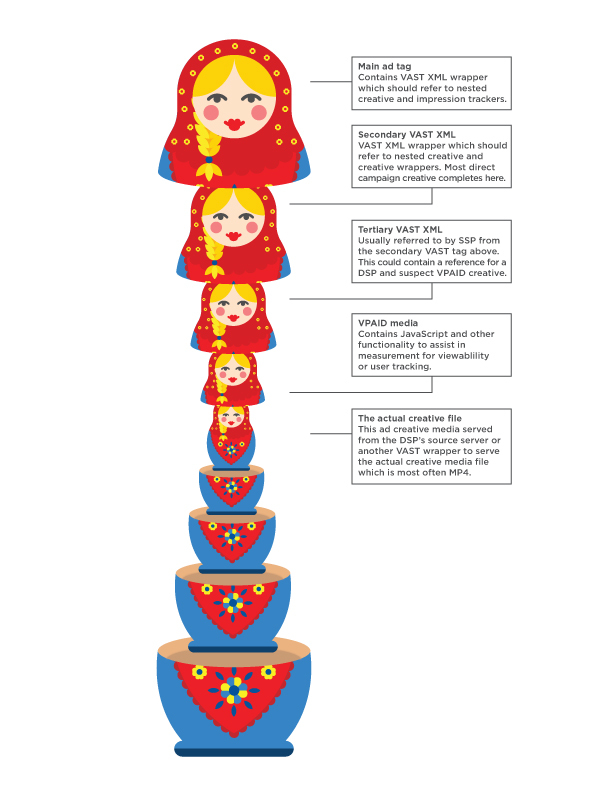I was recently investigating a problem with the inventory of one of the largest sites in Australia. The site was using nested players to override the playback controls of the actual video players on the page. The only way for a user to mute or stop the player was to close the browser or tab.
In addition to the obvious problems of being very annoying for both end users and site owners, the fact that this is allowed on sites and networks points to a larger problem in our industry.
Digging deeper, we found that there were too many wrappers for the ad unit [Digital Video Ad Serving Template (VAST)] (https://www.iab.com/guidelines/vast/), and there were 11 impression trackers when there should normally only be two. These layers have a negative impact on viewability metrics, and can lead to serious negative effects such as a poor user experience, delays, or the complete failure to display ads.
What’s worse, it increases the error rate of video campaign completions. Why does this happen?

– __Main ad tag:__ Contains a VAST XML wrapper that references nested creatives and impression trackers
– __Secondary VAST XML:__ Contains nested creatives and VAST XML wrappers that reference creative wrappers. Most direct campaign creatives are completed here.
– __Tertiary VAST XML:__ Usually referenced by SSPs from the secondary VAST tag above. Includes references to DSPs and suspicious VPAID creatives.
– __VPAID media:__ Includes JavaScript and other functionality to support viewability measurement and user tracking.
– __Actual creative file:__ This ad creative media is served by the DSP’s source server or other VAST wrapper to serve the actual creative media file. The media file is usually an MP4.
## Tip of the iceberg
Until a new method of measuring viewability comes along, vendors will have to measure via VPAID ([Video Player Ad-Serving Interface Definition](https://iabtechlab.com/standards-old/video-player-ad-interface-definition-vpaid/)). However, VPAID is more permissive than other, stricter VAST methods of video ad serving, and so it is prone to abuse. This is particularly true because it is possible to write VPAID tags in JavaScript, which means there is room for creativity, but also for abuse.
As a result of including VPAID in networks, it is not uncommon to see interactive video ad units and nested video players displayed within video ad content, which is terrible for the industry as a whole. Simply put, the way analytics are implemented to measure viewability is breaking everything.
It’s time to stop the “matryoshka” hack of video advertising. Clean ads make for a better customer experience and lead to better ratings. So there is nothing more important than creating as many ad opportunities as possible and making the most of them. So what should we do?
– __Differentiate video inventory:__ Differentiate video for direct, programmatic OTT TV, video on demand (VOD), live streaming, desktop and mobile web, according to their weaknesses and strengths.
– __Empower good SSPs:__ Reputable supply-side platforms (SSPs) are worth investing in to maintain ad quality. SSPs can also provide services that help you to set rules for the file types available on your site or network.
– __Enforce device-specific media types:__ Manage apps and sites that provide nested hacks and define the rules for which ad media to serve to the end user.
– __Don’t use VPAID:__ Develop SSP rules, implement programmable guaranteed campaigns, and ensure that you are not retaining nested players, pixel tracking, or non-guaranteed tracking.
– Provide tools and educate your Ad-Ops: Teach your Ad-Ops team how to spot bad code, tags, wrappers, pixels, etc. in video ad tags by just looking at them. Provide tools like debug consoles to add valuable resources.
## What to do next
The tips above can be applied to client-side ad insertion, but in addition to solving many ad management challenges, [Brightcove’s Server-Side Ad Insertion](https://www.brightcove.com/ja/products/ssai/) can do much more. Our technology can help you mitigate ad quality and ad blocker issues at once. We can help you reach and monetize your audience, delivering premium, TV-like experiences across any device, regardless of platform, device, network or potential hurdles.
The “matryoshka” problem is just one of many that plague the video industry today. Brightcove will continue to tackle the important issues of video ad quality and management head-on.
This is the first article in a series discussing ways to get out of the quagmire of important issues such as header bidding, VAST tag research, and delays. Stay tuned for the next article.




